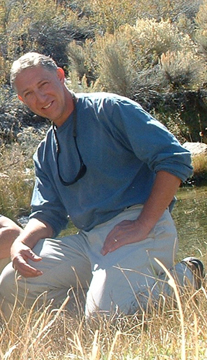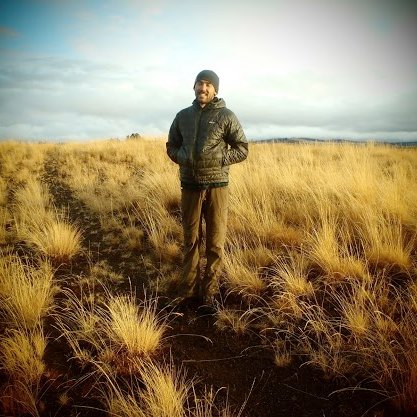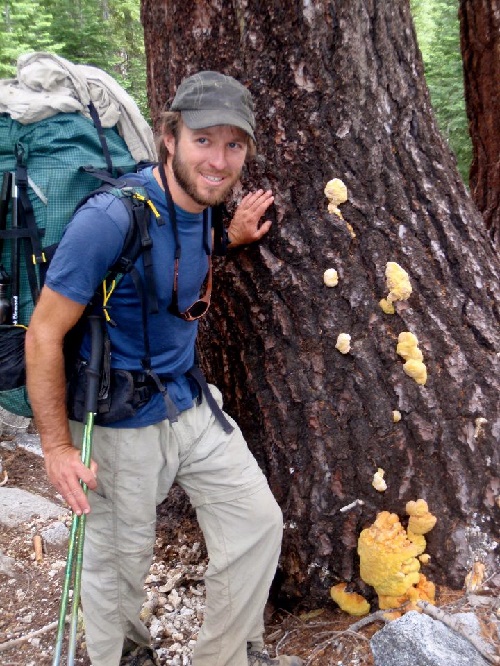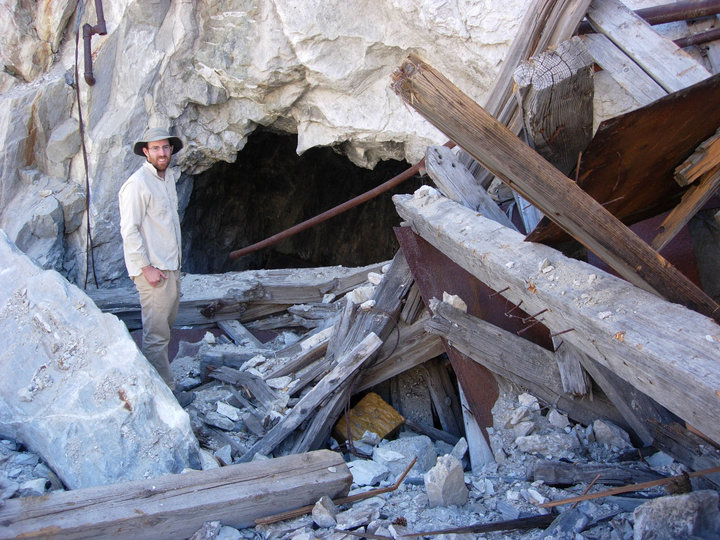
David B. Herbst, Ph.D.
Education/Biography:
Bachelor of Science, University of California at Davis, 1976
Master of Science, Oregon State University, 1981
Ph.D., Oregon State University, 1986
Google Scholar Website
Just out of college back in 1976, I became involved in a research project with other students in a study of Mono Lake, a saline desert lake in California on the east side of the Sierra Nevada. With streams diverted away from the lake into aqueducts bound for Los Angeles, the lake was shrinking and salinity rising. Birds feeding and breeding at the lake depend on aquatic invertebrates as food, so the pressing conservation question was, how does salt stress affect the ecosystem? This led me into research on the limits of physiological adaptation to hypersaline water chemistry, and the growth, life cycle, abundance and distribution of invertebrates in salt lakes. This research ultimately played a role in halting stream diversions, protection of Mono Lake, and showing how salinity controls lake productivity. This introduction to the work of a scientist being involved in habitat conservation through basic and applied research has remained a central theme in my career. Studies at other salt lakes of the Great Basin, and even in Bolivia, have given insight into ecological processes at these lakes through a comparative ecology approach. This work has also given me a taste for exploration because many of these lakes had not previously been studied, or even surveyed. The same is true of mountain streams of the Sierra Nevada, and desert springs of the Great Basin. These obscure and often remote habitats have provided a wealth of opportunities for exploration of the frontiers of inland freshwater environments, and for using research to understand ecological threats and employ invertebrate indicators for detecting impacts and managing for restoration. Working out of a field station has been somewhat isolating, so collaboration with other scientists has been vital. In addition, I have been active in environmental education and local conservation, serving as a member of the Board of Directors of the Yosemite Institute, and Friends of the Inyo.
R. Bruce Medhurst
Education/Biography:
Bachelor of Science, University of Wisconsin Stevens Point, 1999
Master of Science, University of Alaska Fairbanks, 2005
Google Scholar Website
After finding a civil engineering education unsatisfying, I began an undergraduate program in aquatic toxicology at the University of Wisconsin Stevens point in 1995. Course work in Limnology and aquatic invertebrate ecology with Dr. Stan Szczytko, as well as bio-monitoring internships, set the course for a career path that has been immensely rewarding. After various positions elsewhere, I accepted a position with the Herbst Lab working with Dr. Dave Herbst in Mammoth Lakes, CA. in 2001. Dr. Herbst’s approach to question based inquiries has fostered an academic feel in the lab where new skills are constantly required to address pressing questions regarding conservation of stream ecosystems throughout the Sierra Nevada and Great Basin. After attending graduate school at the University of Alaska Fairbanks in 2005 to examine how eco-regional climate influences forest management impacts on aquatic systems, I returned to the Herbst Lab in 2008. My primary role in the lab has been as an invertebrate taxonomist, including identification of midges (family Chironomidae). I have been active in developing Access databases and developing programs in R-computing for management and analysis of invertebrate community, physical habitat, and hydrologic data. More recently I have been involved with bridging the gap between science and the public. I have found that if the public is to support scientific work and facilitate it’s funding, either directly or through their voice and vote, they must have access to a strait forward synthesis of the work. To that end I have taken on website development as a means to share scientific results and raise the profile of local and statewide science. I have enjoyed participating in educational opportunities such as training Yosemite Institute instructors in aquatic ecology and leading field outings as part of the Eastern Sierra Fly-fishing Fair in Mammoth Lakes, CA. I see continued involvement in applied research and public outreach as the best means of ensuring that the dwindling high mountain and desert aquatic ecosystems, which are vital to the west, are preserved and protected.

Ian D. Bell
Education/Biography:
Bachelor of Arts, Whitman College, 2009
A childhood of hikes and mountain bikes in the foothills around Los Angeles eventually led me to the Pacific Northwest and a degree in Environmental Studies from Whitman College. After finishing school, I worked for the US Forest Service's Boise Aquatic Sciences Laboratory, conducting field studies in support of stream sediment pollution studies in Washington, Oregon, California, Utah, Montana, and Idaho. After a few seasons exploring the streams, gullies, and forest roads of the American West, I returned to my home state of California, settling into mountain life in the Eastern Sierra. I served a year-long AmeriCorps volunteer term as a Watershed Technician for a local non-profit organization, performing watershed monitoring and leading volunteer-based restoration and monitoring programs. Fate landed me a job with the Herbst Lab in late 2011, and now I spend my time doing Geographic Information Systems analysis, fieldwork for our desert lake and Sierra streams research, and laboratory processing, identification, and number crunching.

Mike Bogan, Ph.D.
Education/Biography:
Bachelor of Science, Cal State Monterey Bay, 2001
Master of Science, Oregon State University, 2005
Ph.D., Oregon State University, 2013
Google Scholar Website
After moving from the rain-drenched Pacific Northwest to sun-soaked Southern California in 1995, I became interested in water issues (and specifically the scarcity of water in arid landscapes). This led me to seek a place where I could learn more about rivers and streams, which I did for my undergraduate degree at California State University Monterey Bay. Though I studied subalpine forests for my undergraduate thesis, I used my contacts at Cal State (namely my wonderful advisor, Dr. Bob Curry) to get a job at the California Department of Fish and Game in 2000, where I put my undergraduate biology and hydrology training to good use. At Fish and Game, I worked on the study and conservation of progressively smaller and smaller aquatic critters: first trout, then frogs, then pupfish and springsnails. A chance meeting with Dr. Dave Lytle on Independence Creek, California, and a desire to learn more about the taxonomy and ecology of aquatic invertebrates, led me to Oregon State University in 2003. Dr. Lytle introduced me to the small, isolated streams of the Madrean Sky Islands in Arizona and Mexico, where I conducted my Master’s thesis examining the diversity and community structure of aquatic insects across the region. After graduating in 2005, I went back to the Eastern Sierra and started working with Dr. Dave Herbst at the Sierra Nevada Aquatic Research Lab, where I put my new invertebrate taxonomy skills to use on a number of biomonitoring projects and refined my taxonomic skills for some groups (e.g., Chironomidae). In 2007, I went back to Oregon State University for my PhD, where I examined how drought and dispersal act to shape arid-land stream communities. My work with Dr. Herbst at SNARL was rewarding enough, though, that I continued to work part-time for SNARL the entire time I was getting my PhD. I received my PhD in 2012 and have continued conducting research with Dr. Herbst since then, as well as initiating new collaborative studies on the effects of drought on aquatic ecosystems in California, Arizona, and Mexico.

Scott Roberts
Education/Biography:
Bachelor of Arts, Appalachian State University, 2002
Master of Science, University of Tennessee, 2006
I lurched back, tripped, and almost fell face down in the river sputtering "THAT thing lives under that rock!" This was my first reaction to Dr. Herbst initiating me into the wonderful world of aquatic macroinvertebrates. Trained as a geographer at Appalachian State University (B.A.) and University of Tennessee (M.S.), I had spent the previous years immersing myself in the spatial patterns of watershed resources from a broad-scale perspective. From analyzing the spatial variability of thermal springs in Yellowstone National Park to assessing the devastating loss of the Eastern Hemlock from riparian forests of the southern Appalachians, my research focus was always broad. I joined the Herbst Lab in 2006 where I was able to explore how landscape-scale spatial patterns drive fine-scale biological processes. While working with Dr. Herbst, I have had the opportunity to contribute to a wide array of work including: the development of a climate change monitoring network for headwater streams of the Sierra Nevada; database creation and management of 20+ years of aquatic bioassessment data; documenting the toxicity limits of benthic invertebrates as their populations fluctuate in response to anthropogenic increasing water salinity; and an examination of the relationship between spatial scales of landscape disturbance, in-stream sediment conditions, and biological communities. Although I am now physically located in the San Juan mountains of Colorado, my heart and research interests still lie with the Herbst lab - underneath a rock - in some stream, spring, or lake of the Sierra Nevada, Coast Range, or Great Basin desert.

Bruce G. Hammock, Ph.D.
Education/Biography:
Bachelor of Science, University of California Berkeley, 2001
Ph.D., University of California Davis, 2012
Google Scholar Website
Bruce Hammock's Personal Website
Fed up with school and desperate to climb in the Eastern Sierra, I interviewed for an invertebrate taxonomy position with Dr. David Herbst. “I understand you’re excited about living in the Eastern Sierra,” he said “but are you sure you’re serious about learning taxonomy?” Hmmm, this sounds like more school, I thought. “Oh yes,” I assured him, “I’ll be coming to learn!” To my surprise, the next year turned out to be a far more intense and rewarding learning experience than my time as an undergraduate at UC Berkeley. I was hooked on streams, and recently received a Ph.D. in stream ecology at UC Davis. Dr. Herbst was on my dissertation committee, and he provided support (financial, laboratory, academic) throughout my time in graduate school. In general, I combine observational and experimental data to broaden understanding of aquatic ecology. My dissertation research focused on the behavioral ecology of stream invertebrates and how that ecology is affected by global change (i.e., climate and invasive species). More recently, I've studied how stream communities develop on recently submerged substrate (e.g., gravel bars that are submerged as flow increases). Specifically, I'm interested in how community development is affected by certain key taxa. Currently, I’m a postdoc in the Teh lab at Davis studying the effects of urban storm runoff on stream communities and Sacramento-San Joaquin Delta copepods. I am proficient in R, and have experience using and teaching a variety of statistical techniques, including, model comparison, AICc, mixed models, binomial, beta-binomial, Poisson, and gamma-Poisson generalized linear models, as well as frequentist statistics (e.g., ANOVA, regression).

 David B. Herbst |
David B. Herbst |